Features - May 17, 2000
Bicycle follies
A dare-to ride from Princeton to Vassar-became a scam and then a race
Ed. Note: "From the Archives" in paw's Dec. 15 issue showed
a photograph of five men on a bike; one later wrote to explain that they
were training for a race against Robert "Super-Spokes" Schulze
'56 from Princeton to Vassar. The ensuing letters prompted this reminiscence
about how all that long-distance biking got started.
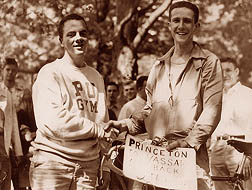 In the early spring of 1955 four of us seniors were driving back to
Princeton from Vassar. (Savvy old-timers will note that driving a car during
the school year back then was strictly illegal and grounds for dismissal,
but that's another story.) The weekend had been the occasion of the annual
Yale to Vassar bicycle relay race, in which teams each rode about 10 miles.
A modest crowd had gathered to see the Yalies pedal across the finish line.
In the early spring of 1955 four of us seniors were driving back to
Princeton from Vassar. (Savvy old-timers will note that driving a car during
the school year back then was strictly illegal and grounds for dismissal,
but that's another story.) The weekend had been the occasion of the annual
Yale to Vassar bicycle relay race, in which teams each rode about 10 miles.
A modest crowd had gathered to see the Yalies pedal across the finish line.
As we drove home to Princeton Sunday night, the discussion in our car
veered from beer and Houseparties (some things never change) to that vision
of exhausted Yalies keeling over after the finish of their 10-mile stint.
Somebody said we ought to organize a relay race from Vassar to Princeton.
I said that was a stupid idea; the 135-mile journey was nearly twice as
far as from Yale to Vassar and you had to travel through New York City and
on truck routes.
That led to an animated discussion as to whether anybody could possibly
ride from Vassar to Princeton on their own. This was 1955, mind you, when
bike riding was mainly the province of paper delivery boys and grade school
kids. There were no mountain bikes at all, and the bikes that a few Princeton
students used on campus were Raleigh 3-speeds and assorted clunkers.
I said I might consider making the ride if I had an unlimited amount
of time and was given $1,000 for my ordeal. Pete McKinney piped up from
the back seat, "I'll do it in 24 hours for 100 bucks." Cries of
disbelief from the rest of us evolved into a challenge, a plan, and a new
man on campus: Marathon McKinney.
None of us had anywhere near $100 so we cooked up a story: McKinney was
said to owe that much on his U-Store bill, and as every student knew, you
could not graduate if you still owed money to the U-Store. To resolve McKinney's
purported crisis he was to ride from Vassar to Princeton, finishing on the
Saturday morning of Houseparties. The revenue generator was a raffle system
whereby students guessed how long it would take McKinney to make the ride.
Each guess got you a ticket stub thanking you for your "magnanimous
contribution of 25 cents American to Marathon McKinney in his great race
against death and his U-Store bill." The winning guesser was to get
$100, and McKinney was to get his liberating $100.
A pretty good buzz was created. There was a stream of articles in The
Daily Princetonian, and just before the event, generous feature stories
with maps of McKinney's route appeared in The Philadelphia Inquirer and
The New York Times.
We even got McKinney to borrow a bike and practice a little. He took
a jaunt toward the Jersey shore and returned with bad news and good news.
The bad news was that he really didn't like riding a long distance on a
bicycle, something that he had never done before. The good news was that
his pace was fairly brisk. So what was originally thought to be a 24-hour
trip was looking more like one of 14 hours. Instead of starting from Vassar
at 10 a.m. Friday as announced, we would start around dinner time.
Then something happened. At a meeting at Tower Club called to pump up
raffle ticket sales I was well into my spiel when somebody I had never seen
before stepped forward. He offered to race McKinney from Vassar to Princeton.
Race? McKinney looked at me with an expression of utter horror. Making the
trip was a bleak enough prospect; racing somebody was out of the question.
So I brushed the guy off and hoped he would vanish. He did not.
The uninvited guest at Tower Club was a junior named Robert Schulze.
He subsequently told the Prince that McKinney was chicken and that he, Schulze,
would leave Princeton at 10 a.m. Friday, do the round trip and still beat
McKinney to the finish line on Prospect. Upon reading the first few paragraphs,
the Marathon McKinney team scoffed. Then we read the rest of the story and
became extremely nervous. Schulze, in addition to being a quietly nice guy,
actually knew how to ride a racing bicycle. He owned one and had ridden
it long distances.
We were in deep trouble. But we were too far into the project to back
out. What would we do, find everybody who had bought a raffle ticket and
give them back their money? We had already spent a lot of it on training
supplies, mainly beer.
So we pressed on. As Houseparties approached we loaded McKinney and his
bike into a car and headed for Poughkeepsie. Just after 10 a.m. we fielded
a discouraging phone call from one of our group back in Princeton; Schulze,
as promised, had just raced off from the Mather Sundial to a round of cheers.
What to do? Prudence would dictate that McKinney leave Vassar post haste.
But leaving now would put him into Princeton late Friday night and blow
my planned arrival celebration.
So we waited and waited, with McKinney getting more antsy by the hour.
Finally, just after dinner, we set off, McKinney pedaling and me driving
behind. We had gone no more than a few miles when an astonishing sight greeted
me. Pedaling briskly up the other side of the road was Schulze!
McKinney had not seen him ride past. So I pulled alongside and said we
had to stop for gas and for him to keep pedaling. I found a pay phone, reached
friends at Vassar, and outlined our grim situation. The Vassar contingent
had an answer: They said they would greet Schulze warmly, offer him a spot
to shower and have dinner, and generally slow him down.
While he was grabbing a bite to eat they hid his bike in some bushes.
Exactly how long Schulze searched for his missing bike I do not know,
but eventually the women "found" it for him.
Meanwhile, McKinney pedaled through the night, crossed the George Washington
Bridge, and dodged trucks as he headed south on U.S. 1. Part of the arrival
celebration was to be the long haul up Washington Road from Lake Carnegie.
About 8 a.m. McKinney hove into view, and a crowd in front of Cannon Club
gave him a resounding cheer. Schulze was nowhere in sight. Our beads of
nervous sweat began to dry. But as we turned to toast the triumph of Marathon
McKinney, another cheer arose. Coming from the other direction on Prospect,
having taken the back way, was Schulze. He had done the round trip in 22
hours, and that included time spent hunting in Vassar's bushes for his missing
bike.
Epilogue: McKinney appeared on TV's "What's My Line?", won
a few prizes, paid his U-Store bill (which was never that big, anyway),
and graduated. Schulze lost his life the next year, hit by a car while riding
his bike from the driveway of Terrace Club onto Washington Road, the thoroughfare
he had avoided on his epic ride from Vassar.
Steve McNamara is editor and publisher of Pacific Sun, an alternative
newsweekly in Marin, California.
Oh, take a hike . . . around Princeton

Click on the above image to download an enlargement
of map.
ORANGE ROUTE
1. Begin at the top of Mercer Street. The far corner boasts a semicircular
stone seat, inscribed as a memorial to those who gave their lives in World
Wars I and II, Korea, and Vietnam. The yellow house at 6 Mercer is the Nassau
Club, built on the site of the only Princeton house burned to the ground
by the British in 1776.
2. Stroll down Mercer Street, passing 43, where the first of Princeton's
eating clubs, Ivy, had its original home. The house was built by Richard
Stockton Field in 1847 to house what he hoped would be the law school. It's
now part of the Trinity Episcopal Church complex.
3. Continue to the Princeton Theological Seminary, which opened in 1812.
Its main building, Alexander Hall-named after its first professor, Archibald
Alexander-dates to 1815.
4. Near the foot of Edgehill Street is 112 Mercer, occupied by Albert
Einstein from 1932 to his death in 1955. Because Einstein did not want his
home to become a museum, the home continues as a private residence.
5. Walking up Edgehill, pause briefly at number 32, the Barracks. The
home incorporates part of the oldest house in Princeton and was used as
a barracks during the Revolutionary War. Local legend has it that the ghost
of a Hessian soldier once haunted the house.
6. 83 Stockton Street is known as the Walter Lowrie House after the 1890
university graduate. A university guest house for a number of years, it
is now the official home for university presidents.
8. Morven, currently under restoration, was built by Declaration of Independence
signer Richard Stockton in 1748. His wife, Annis Boudinot Stockton, entertained
George Washington and members of the Continental Congress there. Morven
was the official residence of New Jersey governors until that honor shifted
to Drumthwacket (344 Stockton Street, former home of university benefactor
Moses Taylor Pyne 1877) in the late 1980s.
9. Outside Princeton Borough Hall is a monument to the Battle of Princeton,
showing a triumphant George Washington. Ironically, a few steps away is
a J. Seward Johnson sculpture, The Newspaper Reader, in which The New York
Times of August 9, 1974, reports the resignation of another president, Richard
Nixon.
10. Crossing Bayard Lane at the corner of Nassau Street (Stockton becomes
Nassau at this point), peek at the recently restored Palmer House, given
to the university by the widow of Edgar Palmer '03 and now used for distinguished
university guests.
BLACK ROUTE
1. Begin at Palmer Square's Tiger Park, across from Maclean House. This
vest-pocket park honors Edgar Palmer '03, who developed Princeton's town
center (and who honored his father with the late Palmer Stadium). From one
of the park's shady benches you can watch who and what goes by along Nassau
Street, once a Lenni Lenape Indian trail and later a stagecoach route between
New York City and Philadelphia.
2. Cross Palmer Square's green lawn to the Nassau Inn. Skip the main
entrance with its big red doors and slip through the door on the far left
into The Tap Room to see the Norman Rockwell mural, Yankee Doodle. Enjoy
the pub's Wall of Fame, featuring Princeton luminaries such as Charlie Gibson
'65 and Brooke Shields '87.
3. If you make it out of the Tap Room with your sense of direction still
intact, walk down Palmer Square to Hulfish Street, make a right, and go
one block to Witherspoon Street; make a left and go to the corner. You'll
see Princeton Cemetery, the resting place of many prominent figures in American
history. To tour the grounds, go north on Wiggins Street, and turn left
on Greenview, where the main entrance is located. Maps are stored in the
little box just inside the gate. On the grounds, look for the markers for,
among others, Sylvia Beach (publisher of James Joyce's Ulysses), duelist
Aaron Burr, Jr. 1772 (third vice president of the U.S.), Grover Cleveland
(22nd and 24th president of the U.S.), novelist John O'Hara, physicist John
von Neumann, and the parents of singer Paul Robeson. And don't miss the
area where the former presidents of Princeton are buried.
4. Leaving the cemetery from the main gate, return to Wiggins and make
a left. Cross to Vandeventer Street and head toward Nassau Street. Revolutionary
War buffs may want to note Beatty House, 19 Vandeventer, where the Marquis
de Lafayette stayed in 1825. (The university conferred an honorary degree
on him in 1790.)
5. Reaching Nassau Street, turn right to number 158, Bainbridge House,
home of the Princeton Historical Society. The circa 1766 house hosts exhibits
about Princeton and a gift shop. It's named for Dr. Absalom Bainbridge,
who was loyal to the Crown and left Princeton soon after son William was
born. William redeemed the family name by becoming a commodore in the U.S.
Navy in command of the U.S.S. Constitution, better known as Old Ironsides.
The Making of a 25th
Wine-tastings, fire engines, and duking it out over jackets
On May 27, the Class of 1975, accompanied by a legion of spouses, children,
and significant others, will stride through FitzRandolph Gate to lead the
Reunions P-rade. Its entrance, in a blaze of orange and black, will be hailed
by brass bands and applauded by hundreds of other Princetonians. Spectators
will have no hint that this festive display, with its attendant weekend
of reunion activities, was two years in the making.
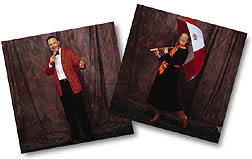 "It's a labor of love," says Reunion Chair Carl Yudell
'75 of the long preparations that will culminate in his class's 25th reunion-a
celebration 1975 has dubbed the Millennium Moment.
"It's a labor of love," says Reunion Chair Carl Yudell
'75 of the long preparations that will culminate in his class's 25th reunion-a
celebration 1975 has dubbed the Millennium Moment.
Having chaired the class's 10th reunion, Yudell knew-"or should
have known"-what he was getting into when he volunteered to chair the
25th. "The jacket!" Yudell exclaims. "People don't care that
much about a tie. A T-shirt doesn't define them. But when you pick a jacket
for the 25th reunion, one that will identify the class from then on-well,
people have strong opinions."
More time and effort than a non-Princetonian would believe possible go
into designing a 25th reunion class uniform. The first meeting of 1975's
reunion committee, which eventually numbered 25, was in May 1998. Yudell
recalls the date as "the beginning of the 'Jacket Wars.' There's always
a difference of opinion," he points out, "as to whether people
want something classic or something wild and crazy-and even 'classic' and
'crazy' mean different things to different people." So different, in
fact, that Yudell has received about 500 e-mail messages on the subject.
("Mostly favorable," he notes.)
Largely responsible for the eventual fabric design (and many other graphic
elements associated with class reunion publicity) was Gail Baumbach, wife
of publicity chair Bill Baumbach '75. Working with members of the class
and Laurel Cantor, the university's art director, she provided iteration
upon iteration of tigers, stripes, and numerals. It took most of the eight
committee meetings held throughout 1998 and 1999 before one garment emerged
victorious: a jacket in "Transposing Tigers" fabric-black tiger
heads upright for men, orange and cream tiger heads upright for women, all
tigers emblazoned "75." This jacket, enthusiastically accepted
by-well, almost everyone-will be worn with signature shirts (polo for men,
scoop-neck for women), Panama hats, belts, and scarves.
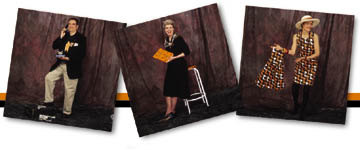
The class uniform and ancillary regalia (T-shirts, tote bags, kids' clothes,
baseball caps, umbrellas, mugs, balloons) engaged but necessarily could
not monopolize the creative energies of the reunion committee. There are
too many other aspects of a 25th reunion that must be attended to. Among
them: ongoing publicity; reunion headquarters in Wilson Courtyard (tents,
tables, chairs, electricity, sound systems); entertainment (dance bands,
singing groups, background music); housing (rooms on campus and in local
hotels); meals (four days of them, and don't forget the snacks); beverages
(for those over and under 21); programs for children (Tiger Camp at the
local Y); the P-rade itself (bands, marshals, vehicles such as '75's fire
engine); and, of course, finances (how much do you charge to break even
when you don't know how many people are coming, and other fiscal conundrums).
While some committee endeavors wind down as the reunion approaches, others
accelerate. The first publicity mailing to the class went out in June 1999:
an invitation to attend '75's Millennium Moment (MM is 2000 in Roman numerals,
committee members point out), along with a handsome Many Memories poster
featuring representations of campus buildings and scenes culled from the
university archives. The first registration forms went out in November,
followed by postcard reminders and second-chance registration forms. Publicity
efforts continue, with a last-minute all-hands-on-deck phonathon to unregistered
classmates scheduled for early May. The class Web site (www.pu1975.org)
posts all mailings, fabric designs, committee minutes, Annual Giving tallies,
and an updated list of classmates attending the reunion.
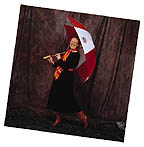 The importance of what the Class of 1975 will wear, where it
will sleep, and what it will eat and drink cannot be overestimated. Yudell
jocularly credits Craig Tyl '75, food and beverages chair, with "one
of the more stressful jobs: sampling wines to be served at the meals."
The importance of what the Class of 1975 will wear, where it
will sleep, and what it will eat and drink cannot be overestimated. Yudell
jocularly credits Craig Tyl '75, food and beverages chair, with "one
of the more stressful jobs: sampling wines to be served at the meals."
Still, there are many other projects that are an integral part of a successful
reunion. John Allyn '75, for example, monitors all reunion finances, and
tracks the approximately 6,000 individual clothing item orders and confirmations.
Michael Kelley '75 spent several days in Mudd Library researching a class
chronicle to be delivered from the reviewing stand during the P-rade. Another
ongoing effort, coordinated with the Alumni Council and other reunion classes,
has been the search for classmates to participate in alumni-faculty forums;
approximately eight members of the class will do so. The program chair,
Diane Weeks '75, is also spearheading a community service effort, Clothes
Out the Millennium, for which classmates are urged to bring clothes to donate
to local charities.
As always, a legacy of this 25th reunion will be the class yearbook,
edited for the Class of 1975 by Melissa Kiser '75. She mailed a questionnaire
to classmates early last fall, setting a deadline of November 20 for returns.
"We heard from about 50 percent of the class," she says-though
not quite by November 20. The now-finished volume is being mailed to all
of 1975, whether or not they attend the reunion.
And a reflective interlude, organized by Howie Kiser-Melissa's mother
and an honorary class member-will be the class's Memorial Service, held
on Friday afternoon in the chapel. "Amid the gaiety and fellowship
of Reunions," she says, "it's important to remember the classmates
who can't be here." Accordingly, returning members of the original,
1,100-strong Class of 1975 will gather to honor 35 "absent friends."
By Reunions weekend, thousands of man hours, woman hours, and
even kid hours (ask committee members: Reunions is a family affair) will
have gone into creating the Millennium Moment. The logistics of this weekend
extravaganza would be even more daunting were it not for the support of
the Alumni Council. Its "Reunions Handbook" has been " '75's
sine qua non," says Yudell. "We pretty much followed the schedule
they laid out."
From suggested dates for reunion committee meetings ("Start at least
18 months ahead of time"); to headquarters arrangements ("By Jan.
1, complete carpentry and electrical requirements form and tent order");
to housing ("One year prior: reserve public space"); to food and
beverages ("Fall '99: meet with Sue Pierson of Dining Services to plan
reunion meals"); to the P-rade ("Winter '99: contact a band to
march in front of the class; locate the class banner"); to publicity
and promotion ("March '99: design letterhead; draft first mailing to
class"), the Handbook leaves no reunion-planning stone, or even pebble,
unturned.
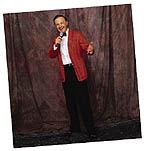 "That book is absolutely key," says Yudell. "It's the
sacred scripture, the cookbook-whatever you want to call it, you can't do
without it. It tells everyone what to do and when to do it.
"That book is absolutely key," says Yudell. "It's the
sacred scripture, the cookbook-whatever you want to call it, you can't do
without it. It tells everyone what to do and when to do it.
"If you follow the book, there are no problems." And if anything
is not in the book-for example, What activities might interest children?-he
says, "You call Adrienne Rubin '88 or Maggie Johnson at the Alumni
Council. They've been great."
As to whether a 25th reunion in 2000 is more significant than one in
a non-millennial year, opinions differ. Aside from offering elegant design
possibilities, the year 2000 "is just a turn of the digits," says
Melissa Kiser; still, she adds, "It makes us part of a century that
is no more."
So what motivates the busy engineers, parents, lawyers, scientists, teachers,
dentists, and business people who make up the Class of 1975 Reunion Committee
to devote large chunks of the spare time they don't have, to organize what
is, Millennium or not, just a Moment?
While "participation is its own reward," according to Yudell,
many committee members speak of their 25th reunion as an appropriate time
"to do something for Princeton." "I am grateful for the opportunity
to serve the class in some small way," says Heidi Bode '75, headquarters
chair. "I have more or less ignored Princeton for much of the last
25 years." For Bill Baumbach, it's "the desire to give back something
to Princeton, which I've come to appreciate more as the years have gone
by."
Clearly, a 25th reunion is indeed special, regardless of what
jacket is worn. "Our lives have really taken shape, and we want to
see how classmates' lives are going, while we are mature but still young,"
says Alex Donner '75, entertainment chair. Observes Diane Weeks, "It's
halftime."
So members of the class look back at Reunions 1975 with some bemusement.
Recalls Bode, "I remember when I was a senior, how old the 25th reunion
class seemed. Now I guess I have a different perspective. They don't seem
old at all."
Caroline Moseley is associate editor of the Princeton Weekly Bulletin.
GO TO
the Table of Contents of the current issue
GO TO
PAW's home page
paw@princeton.edu
 In the early spring of 1955 four of us seniors were driving back to
Princeton from Vassar. (Savvy old-timers will note that driving a car during
the school year back then was strictly illegal and grounds for dismissal,
but that's another story.) The weekend had been the occasion of the annual
Yale to Vassar bicycle relay race, in which teams each rode about 10 miles.
A modest crowd had gathered to see the Yalies pedal across the finish line.
In the early spring of 1955 four of us seniors were driving back to
Princeton from Vassar. (Savvy old-timers will note that driving a car during
the school year back then was strictly illegal and grounds for dismissal,
but that's another story.) The weekend had been the occasion of the annual
Yale to Vassar bicycle relay race, in which teams each rode about 10 miles.
A modest crowd had gathered to see the Yalies pedal across the finish line.
 "It's a labor of love," says Reunion Chair Carl Yudell
'75 of the long preparations that will culminate in his class's 25th reunion-a
celebration 1975 has dubbed the Millennium Moment.
"It's a labor of love," says Reunion Chair Carl Yudell
'75 of the long preparations that will culminate in his class's 25th reunion-a
celebration 1975 has dubbed the Millennium Moment.
 The importance of what the Class of 1975 will wear, where it
will sleep, and what it will eat and drink cannot be overestimated. Yudell
jocularly credits Craig Tyl '75, food and beverages chair, with "one
of the more stressful jobs: sampling wines to be served at the meals."
The importance of what the Class of 1975 will wear, where it
will sleep, and what it will eat and drink cannot be overestimated. Yudell
jocularly credits Craig Tyl '75, food and beverages chair, with "one
of the more stressful jobs: sampling wines to be served at the meals." "That book is absolutely key," says Yudell. "It's the
sacred scripture, the cookbook-whatever you want to call it, you can't do
without it. It tells everyone what to do and when to do it.
"That book is absolutely key," says Yudell. "It's the
sacred scripture, the cookbook-whatever you want to call it, you can't do
without it. It tells everyone what to do and when to do it.